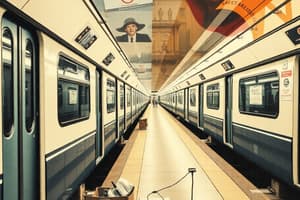Podcast
Questions and Answers
Match the following attractions in Madrid with their descriptions:
Match the following attractions in Madrid with their descriptions:
Museo del Prado = home to Picasso's Guernica and works by Dalí and Miró Reina Sofia Museum = one of the world's greatest art museums Royal Palace of Madrid = official residence of the Spanish royal family Retiro Park = a large urban park with gardens, lakes, and walking paths
Match the following neighborhoods in Madrid with their characteristics:
Match the following neighborhoods in Madrid with their characteristics:
Centro = historic center with narrow streets, plazas, and shops Malasaña = historic center with narrow streets, plazas, and shops Salamanca = upscale neighborhood with luxury shopping and dining
Match the following festivals and events in Madrid with their descriptions:
Match the following festivals and events in Madrid with their descriptions:
La Tomatina = a celebration of Madrid's patron saint with music, dance, and food Fiesta de San Isidro = a celebration of Madrid's patron saint with music, dance, and food Veranos de la Villa = a summer festival with outdoor concerts and performances
Match the following historical periods in Madrid with their descriptions:
Match the following historical periods in Madrid with their descriptions:
Match the following historical events in Madrid with their descriptions:
Match the following historical events in Madrid with their descriptions:
Match the following historical figures in Madrid with their descriptions:
Match the following historical figures in Madrid with their descriptions:
Flashcards are hidden until you start studying
Study Notes
Tourism in Madrid
- Popular attractions:
- Museo del Prado: one of the world's greatest art museums
- Reina Sofia Museum: home to Picasso's Guernica and works by Dalí and Miró
- Royal Palace of Madrid: official residence of the Spanish royal family
- Retiro Park: a large urban park with gardens, lakes, and walking paths
- Neighborhoods:
- Centro: historic center with narrow streets, plazas, and shops
- Malasaña: trendy area with street art, bars, and restaurants
- Salamanca: upscale neighborhood with luxury shopping and dining
- Festivals and events:
- La Tomatina: a famous tomato-throwing festival in nearby Buñol
- Fiesta de San Isidro: a celebration of Madrid's patron saint with music, dance, and food
- Veranos de la Villa: a summer festival with outdoor concerts and performances
History of Madrid
- Ancient and medieval periods:
- Founded by the Arabs in the 9th century as a small fortress
- Conquered by the Christians in the 11th century and became a royal residence
- Played a significant role in the Reconquista, the Christian reconquest of Spain
- Habsburg and Bourbon dynasties:
- Madrid became the capital of Spain in 1561 under Philip II
- The city grew rapidly during the Habsburg dynasty, with the construction of the Royal Palace and other landmarks
- The Bourbon dynasty brought further development and modernization in the 18th century
- Modern era:
- Madrid was a key site during the Spanish Civil War (1936-1939)
- The city underwent significant urbanization and growth in the 20th century, becoming a major economic and cultural center
- Today, Madrid is a thriving, cosmopolitan city with a rich cultural heritage and a strong sense of community
Studying That Suits You
Use AI to generate personalized quizzes and flashcards to suit your learning preferences.




